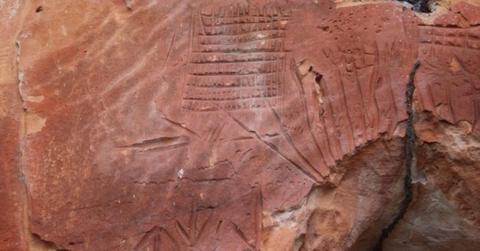Primitive Pictures: 2,000-Year-Old Rock Art Depicting Animals, Human Footprints and Stars Discovered in Brazil

Scientists have unearthed artwork decorating rocks across 16 sites in a tropical region of Brazil.
Scientists have uncovered ancient artwork adorning rocks across 16 sites nestled within the lush landscape of Brazil.
These engravings and paintings offer a captivating glimpse into the beliefs and customs of civilizations that thrived in the state of Tocantins over 2,000 years ago.
The sites, scattered across the rocky expanses of Jalapão, a remote region within Brazil's tropical Cerrado, were subject to investigations between 2022 and 2023.
Lead archaeologist Rômulo Macedo, in a statement from Brazil’s National Historical and Artistic Heritage Institute (IPHAN), described the symbols etched and painted on these rocks, highlighting human footprints, animal depictions such as deer and wild pigs, and celestial bodies.
Macedo emphasized that these discoveries are more than just isolated finds — they reveal a shared belief system among the creators of these rock records, Newsweek reported.
The recurrence of symbols across multiple sites suggests a cohesive cultural narrative, though the identities of the artists remain elusive, leaving historians to speculate on the purpose behind these creations.
- Grave Discovery: Ritualistically Arranged Human Bones Discovered During Mexican Sewer System Excavation
- Villagers in India Unearthed ‘Sacred Stones.’ Scientists Are Stunned by What the Finds Turned Out to Really Be.
- Whale Tooth Earrings and Gold Plates: Ancient Tomb Unearthed in Panama Filled with 1,200-Year-Old Artifacts
Possible interpretations range from recording the passage of time to communicating with spirits, narrating mythical tales or marking territorial boundaries. Notably, the use of red pigments in some paintings suggests a distinct cultural lineage that may predate the engravings.
These artworks are situated within an archaeological complex that has been inhabited by humans for millennia, predating the arrival of European colonizers by thousands of years.
Never miss a story — sign up for the Front Page Detectives newsletter. Be on the scene the moment news breaks.
Despite this rich history, much remains unknown about these ancient societies prior to European contact.
Recent archaeological discoveries shed light on the longstanding presence of human groups in the Jalapão region, with evidence dating back 12,000 years. This suggests that these communities were drawn to the Cerrado's diverse ecosystem, recognized as the most biodiverse savanna globally.
However, the newfound cultural treasures face numerous threats, including wind erosion, vandalism, forest fires and deforestation. To safeguard these invaluable relics, IPHAN has initiated conservation efforts and educational programs in the region, aiming to protect and raise awareness about Brazil's cultural heritage.
Become a Front Page Detective
Sign up to receive breaking
Front Page Detectives
news and exclusive investigations.
